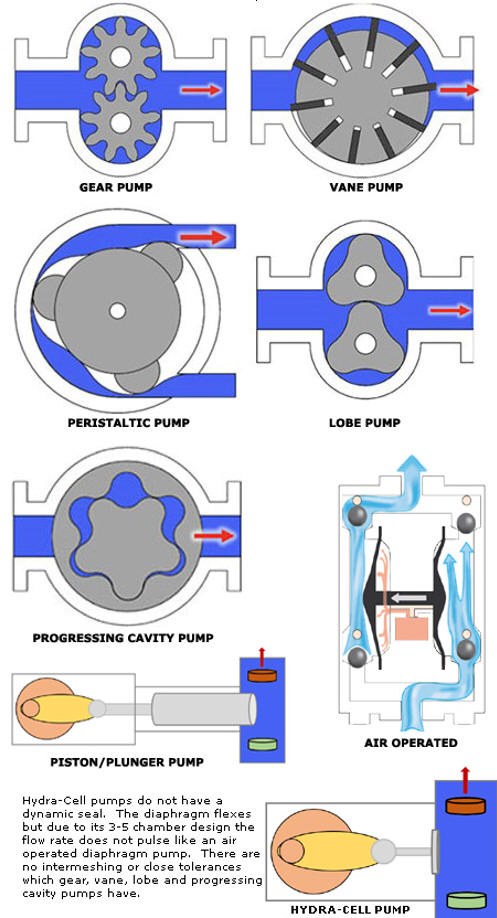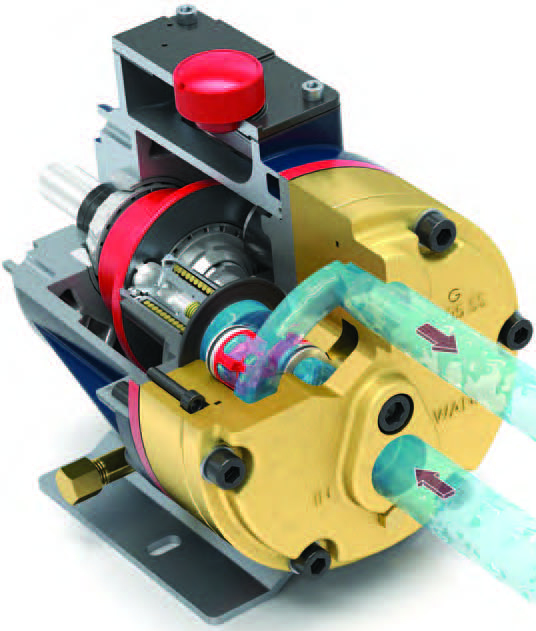Pumping Difficult to Handle
Liquids with Wanner™ Hydra-Cell® Pro Pumps
 Hydra
Cell Pro pumps are a type of positive displacement pump having no
mechanical seals, packing or similar dynamic method to isolate the pumped
liquid from the environment. Each rotation of the pump shaft displaces a
fixed volume of liquid and the discharge pressure reflects the resistance to
flow for that displacement. Stated another way, Hydra Cell Pro pumps output a
flow rate proportional to the pump shaft RPM at whatever pressure is
required based upon downstream restriction. The unique hydraulically
balanced diaphragm design is what sets the Hydra Cell Pro apart from other
positive displacement pump designs which include progressing cavity, gear,
vane, rotary lobe, air operated diaphragm and peristaltic pumps. Most of
these other designs have a seal or pump mechanism which is damaged by
particulate within the liquid, are dependent upon the pumped liquid for
cooling and lubrication of the pump mechanism or are incapable of high
pressures and operating reliably continuously.
Hydra
Cell Pro pumps are a type of positive displacement pump having no
mechanical seals, packing or similar dynamic method to isolate the pumped
liquid from the environment. Each rotation of the pump shaft displaces a
fixed volume of liquid and the discharge pressure reflects the resistance to
flow for that displacement. Stated another way, Hydra Cell Pro pumps output a
flow rate proportional to the pump shaft RPM at whatever pressure is
required based upon downstream restriction. The unique hydraulically
balanced diaphragm design is what sets the Hydra Cell Pro apart from other
positive displacement pump designs which include progressing cavity, gear,
vane, rotary lobe, air operated diaphragm and peristaltic pumps. Most of
these other designs have a seal or pump mechanism which is damaged by
particulate within the liquid, are dependent upon the pumped liquid for
cooling and lubrication of the pump mechanism or are incapable of high
pressures and operating reliably continuously.
Simplicity of Design
Whereas many pumps were
designed for a specific type of liquid or application, Hydra Cell Pro Pumps were
designed to maximize reliability by reducing the frequency, complexity and
cost of pump maintenance. This innovative pump design lends itself to a
broad application base most easily defined as “liquids that are difficult to
pump”.
Liquids Containing Particles
The maximum
particle size for a given Hydra Cell Pro Pump model is related to the pumps
internal check valves and how far they open. The check valves in Hydra Cell
Pro
pumps ensure the direction of flow is from the inlet and through the outlet
of the pump. Piston, plunger and air operated diaphragm pumps have similar
check valves to control the flow path while progressing cavity, gear, vane,
rotary lobe and peristaltic pumps create a mechanical downstream
restriction. The close tolerances involved with progressing cavity, gear,
vane and rotary lobe style pumps result in component wear OR, if those
tolerances are adjusted, less efficient pumping. Peristaltic pumps and air
operated diaphragm pumps are relegated to low pressure applications and
offer some advantages such as suction lift, maximum free passage and the
ability to pump higher viscosity liquids compared to Hydra Cell Pro Pumps.
Pumping Slurries
Liquids having a high
concentration of particles are considered a slurry. Hydra Cell Pro pumps work
well for non-precipitating particulate slurries up to 25% concentration,
which is far beyond where a typical progressing cavity, gear, vane or rotary
lobe pump would be applied with any efficiency. Peristaltic pumps excel at
slurry pumping applications due to their ability to gently pass large
(diameter & length) solids.
Just about any reclaimed or recycled liquid contains particulate,
use of Hydra Cell Pro pumps often reduces the level of filtration required based
upon its check valve design. Even though piston and plunger style pumps have
a similar check valve design, they also have a mechanical seal as a barrier
between the pumping chamber and pumping mechanism. These seals have very
small tolerances and their IOM manuals often specify filtering the pumped
liquid to 25 microns for optimal seal life. Hydra Cell Pro pumps do not have a
mechanical seal, so it’s not a reliability or cost concern to pump particles
>25 microns. Thus, the level of filtration required is coarser and that is
typically less expensive for the filter media as well as for reducing the
frequency of cleaning or replacing the filter element.
Viscous Liquids
Some pumping mechanisms are
better than others for liquids having a higher viscosity than water.
Peristaltic pumps excel at pumping viscous liquids; the efficiency of
progressing cavity, gear, vane and rotary lobe style pumps are increased
with viscous liquids and their internal components benefit from lubricating
liquids. Hydra Cell Pro pumps can handle viscosities up to 1100 cps which is
approximately 5200 SSU. The advantages the Hydra Cell Pro provides for such
applications is the lack of a mechanical seal and ability to handle
particulates.
The viscosity of non-Newtonian fluids varies as they are shear
sensitive and for low pressure applications centrifugal pumps are often
used; Hydra Cell Pro pumps have a gentle high frequency, short stroke and can pump
non-Newtonian fluids like sauces (ketchup), bentonite slurry and paper/pulp
slurry without the solids and viscosity limitations centrifugal pumps have.
Non-Lubricating Liquids
Thin liquids, water,
fuel, solvents, liquefied gases and surfactants are difficult for pump
designs requiring close tolerances of intermeshing internals due to the lack
of a liquid film to protect these components from wear. Likewise, there is
an exponential loss of volumetric efficiency (referred to as slip) for high
pressure applications. Centrifugal pumps work well for such fluids and
customers generally turn to positive displacement pumps when they require
higher discharge pressures; this is where the check valve style flow control
excels compared to the close tolerances required by progressing cavity,
gear, vane and rotary lobe style pumps. Centrifugal pumps are not ideal for
chemical metering applications which typically are low flow rate
applications requiring a consistent flow at variable pressures.
Hazardous Liquids
There are many reasons a
liquid might be considered hazardous, it might be at an extreme temperature,
chemically aggressive, poisonous to personnel or harmful to the environment.
Such applications benefit from a simplified, reliable design with minimal
chance of fugitive emissions and interaction with personnel. Since the only
components of a Hydra Cell Pro pump which are in contact with the pumped liquid
are its check valves and elastomers, they operate effectively with liquids
between 15F and 250F. Another advantage of minimal components is the ability
to offer them in a wide variety of materials to address specific
characteristics of the liquid. Chemically aggressive applications might
benefit from Hastelloy and ceramic check valves while abrasive applications
from stainless steel alloys or tungsten carbide.
The lack of a mechanical seal significantly reduces fugitive
emissions because mechanical seals are a wear component and thus piston,
plunger, progressing cavity, gear, vane and rotary lobe style pumps will
eventually leak.
 Pump sizing and integration into the piping system
Pump sizing and integration into the piping system
Hydra Cell Pro pumps have suction lift ability and therefore might be a better
fit for some low NPSHa applications. Always try to position the pump as
close as possible to the feed vessel to minimize pressure loses. Especially
if it is a pressure-fed inlet condition, oversize the inlet pipe to minimize
turbulence and cavitation; although Hydra Cell Pro pumps are not damaged by
cavitation or a starved/closed inlet, they can only displace liquid
efficiently when the volume of liquid within the pump chamber is equal to or
greater than the displacement rate.
Particulate laden and viscous liquids usually benefit from lower
velocity pumping, referred to as “oversizing” the pump. The slower stroke
rate and larger internal pump pathway reduces the abrasive effect entrained
particles apply to pump components (such as check valves) and there is less
resistance for the liquid to flow into the pump head.
It’s not that the Hydra Cell Pro pump is magical and can do anything,
rather they compete with many different pump designs due to their
innovative, reliable and simplistic design. Difficult to pump fluid
applications can be challenging from many different perspectives. Let us put
our experience to work for you by calling or emailing us with your
application description; we often reply with a proposal or alternative pump
suggestion the same day.





